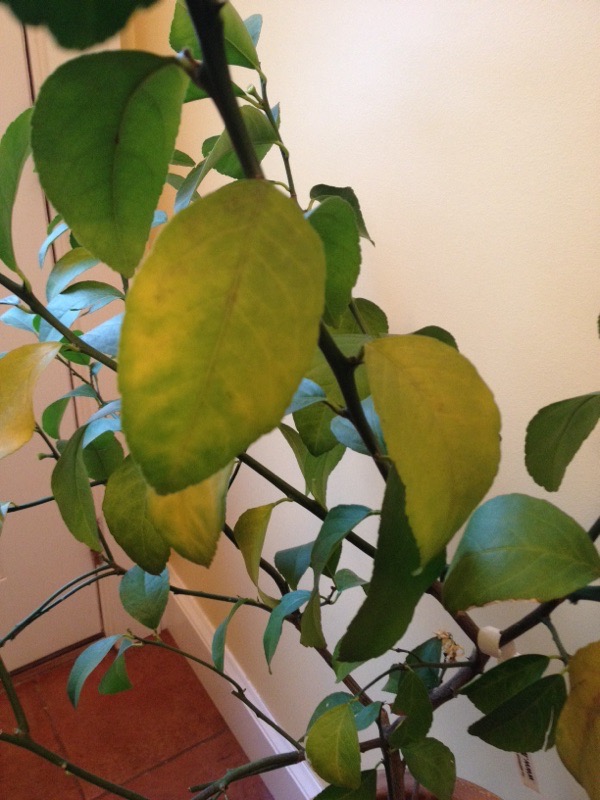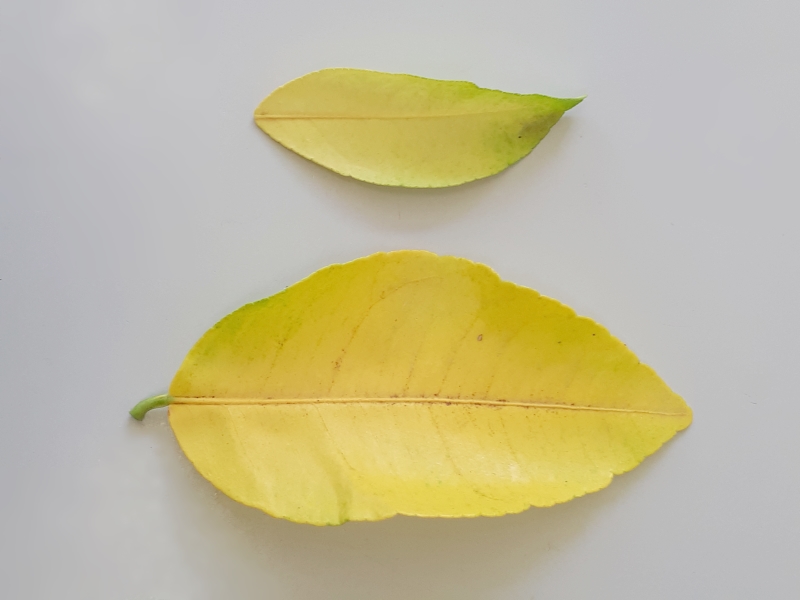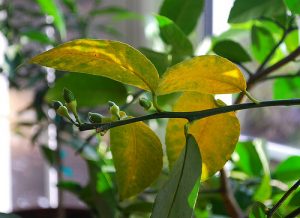
Lower than 50°F temperatures and a nitrogen shortage in the soil cause lemon tree leaves to turn yellow. As well as spider mite infections, which result in tiny yellow spots the size of pins on the leaves, both underwatering and overwatering can cause leaves to become yellow.
Leaf drop is frequently associated with yellowing lemon tree leaves, however with the proper care, the tree can often be rejuvenated.
Learn how to keep your lemon tree’s leaves from going yellow and how to revitalize it by reading on.
Table of Contents
Over Watering Causes Lemon Tree Leaves to Turn Yellow
Lemon trees prefer the soil to become fairly dry between waterings because they are native to warm, sunny areas.
The leaves of your lemon tree may turn yellow as an indication of stress if there is too much moisture near the roots.
Lemon tree leaves get yellow due to:
- Watering too much. The top two inches of the soil should start to feel a little dry before watering, which usually means giving the tree a good shower once a week. The leaves will become yellow (and possibly drop) and the fugal disease root rot, which can kill the lemon tree, will be encouraged by overwatering, which keeps the soil continually moist.
- pots without base drainage holes. Lemon trees should be cultivated in containers with drainage holes in the bottom so that extra water can drain after watering and the soil can partially dry out in between watering sessions. Because some decorative pots don’t have drainage holes, the soil becomes saturated, turning the leaves yellow.
- putting trays beneath plants to stop water from spilling inside. Lemon trees should have any extra water removed from trays every so often because the water might keep the soil moist and inhibit appropriate drainage.
- soils that drain slowly. To avoid leaf drop and yellowing, lemon trees need soils that drain effectively. For potted lemon trees, the ideal soil mixture consists of a third multipurpose compost, a third garden compost, and a third horticultural grit or perlite. This combination provides nutrients and ensures good drainage, which allows the soil to dry out around the roots and prevents the leaves from turning yellow.
Depending on the environment, lemon trees may need to be watered more frequently or less frequently.
While humid climes or regions with higher rainfall may necessitate less regular watering, lemon plants may need more frequent watering in drier climates.
The lemon tree should resurrect if you adjust the frequency of your watering so that the top two inches of the soil dry out considerably between bouts of watering, as this is the proper balance of moisture.
The yellow leaves could fall off, but if you take good care of them and water them properly, they should grow back.
(Read my post on how to water lemon trees to discover how to determine the appropriate watering frequency for lemon trees for your climate.)
Drought Can Cause Lemon Tree Leaves to Turn Yellow
Lemon tree leaves can turn yellow in response to dryness, although they more frequently do so as a result of overwatering because they like soil conditions that are on the dry side.
It is obvious that drought is at blame if the leaves appear shriveled in addition to yellow.
Lemon tree leaves turning yellow during a drought can happen for a number of reasons:
- yellowing of the leaves on indoor lemon trees. Heat, air conditioning, and forced air all zap moisture from lemon tree leaves, causing them to become yellow as a symptom of stress. The air in dwellings is often considerably dryer than outside. To improve the microclimate for your lemon tree, place it away from drafts and heat sources (preferably in a sunny window) and mist the leaves frequently.
- too little watering of lemon trees. If you water the lemon tree too lightly, the soil may be moist on the surface, but the water will not reach the roots, where it is needed, and the leaves will turn yellow. Once a week, give the lemon tree a good bath to the point where a trickle of water comes out of the bottom of the container.
- Sunlight and extreme heat can promote evaporation. Particularly potted lemon trees are vulnerable to drying out in high heat because they can hold less soil and moisture. During heat waves, it’s important to keep an eye on the soil moisture to prevent drought, and if necessary, water the lemon tree more frequently to keep the leaves from turning yellow.
During the growing season, water your lemon tree liberally at least once a week, spraying the leaves frequently to retain some humidity, and your lemon tree should be able to recover.
I advise immersing the entire pot in water for around 10 minutes in a bucket or wheelbarrow full of water for lemon trees that have experienced severe drought.
Drought-related issues are made worse by extremely dry soil, which can bake hard and cause water to flow off the surface rather than reach the roots.
Use a soaker hose to completely water the ground where your lemon tree is located in the garden border so that the moisture can get to the roots.
(Read my article Why are my lemon tree’s leaves curling for additional details.)
Yellow Leaves due to Lack of Fertilizer

When the lemon tree is lacking in nutrients, the leaves begin to droop, become yellow, and occasionally retain green veins while the rest of the leaf turns yellow (chlorosis).
Since pots have a restricted capacity for soil and hence less nutrients for the roots to absorb, this is particularly typical for lemon trees in pots.
In order to maintain healthy-looking leaves and to encourage the growth of blossoms and fruits, the problem can be solved by applying a specific citrus fertilizer once a month during the spring and summer.
Over the coming weeks, the lemon tree should be able to recover from its drooping appearance and yellow leaves with regular fertilizer treatments, excellent watering techniques, and full sun.
However, be careful not to use too much fertilizer as this can also cause the leaves to become yellow. Always carefully follow the manufacturer’s instructions.
Low Temperatures can Cause Lemon Tree Leaves to Turn Yellow
Lemon trees prefer warm tropical areas because they can’t endure frost or extremely cold winters. (9–11 USDA zones)
Your lemon tree’s leaves may turn yellow and drop off under the stress of cold temperatures. Frost can cause the lemon tree to die back.
A smaller lemon tree is more susceptible to cold, which can cause its leaves to drop and become yellow. This is because mature lemon trees are often more cold resilient than younger ones.
However, when the nighttime low falls to 50°F (10°C), lemon trees of all species should be taken inside or to a heated greenhouse and placed in a sunny window for protection and to keep the leaves.
When they are moved indoors, this might cause issues like leaf drop, so I produced another article outlining how to reduce leaf drop when bringing lemon trees indoors for the winter.
Lemon tree leaves do tend to lose their green hue and some may fall off with fewer hours and less intense sunlight.
The lemon tree should recover, though, with new growth appearing in the Spring in reaction to additional light, if it is in a sunny window with regular misting of the leaves and good watering.
Yellow Spots on Indoor Lemon Trees
Spider mites are to blame if you see tiny pin-sized yellow spots on the leaves of your lemon tree as well as possible leaf drop.
Due to the lower humidity in dwellings, spider mites can be a prevalent issue for indoor plants.
Spider mites are a pest that, fortunately, is quite simple to control but, if left untreated, can cause your lemon tree to lose its leaves.
Since they prefer dry environments and moist foliage might aid to oust them, misting with water is an effective discouragement.
But you may get rid of them by simply washing your leaves in soapy water, which will also get rid of the infestation on the lemon tree.
Although it could require multiple treatments to entirely get rid of them, this is a really efficient remedy.
Trim any damaged leaves back, and the lemon tree should recover without incident.
Lack of Sun can Cause Yellowing Lemon Tree Leaves

Lemon trees can be grown by gardeners outside of their natural area, but full sun is necessary for them to flower, bear fruit, and avoid stress-related yellowing and leaf drop.
In order to acquire the best fruit yield and to ensure the health of the plant, it is crucial to place your lemon tree in the part of your garden that receives the most sunlight.
When the lemon tree is moved indoors to avoid frost, problems typically arise since it must deal with:
- fewer solar hours per day.
- lower light intensity.
- Lemon trees need to adjust to the interior environment because they are more shadowed there.
All of these variables may result in a yellowing or dropping of the leaves.
A heated green house is the ideal location for a lemon tree in the winter because it maintains a constant temperature and receives the most natural sunlight.
However, they can survive if you place them in a bright, sunny south-facing window.
Due to the seasonal change and a response to decreased light in the winter, some leaf yellowing and drop may still happen. However, if the lemon tree is in a sunny window, it should recover with new leaves developing and any yellow leaves should look much healthier in the spring.
To learn how to save a dying lemon tree, read my post.
Key Takeaways:
- Lemon trees may turn yellow as a result of inadequate or excessive watering as well as a response to cold conditions. Lemon tree leaves becoming yellow can also be caused by a lack of nitrogen or sunlight.
- An infestation of spider mites results in yellow dots the size of pins on the leaves of lemon trees.
- Lack of fertilizer results in green veins on yellow Lemon tree leaves.
- Lemon tree leaves should turn from a yellow appearance to a healthier green leaf if you place them in full sun, spray the leaves frequently, keep them from temperatures below 50° F (10°C), feed them in the spring and summer, and water once per week with a good soak.
